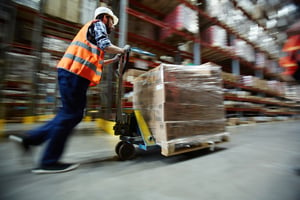
Warehouse operations and distribution facilities are common with most manufacturing businesses and they present a wide variety of potential hazards for your employees and vendors. Generally, very little training is conducted to help recognize these potential hazards. When we review our warehouse losses, we find the most frequent injuries and losses occur in the loading dock area, during forklift operations, and with employee lifting and material handling. To create a safer environment and to improve warehouse and distribution operations, read about common injuries and hazards and learn some warehouse safety tips and controls.
Loading docks or staging areas are areas in a warehouse where injuries and damage to products commonly occur. Common hazards include:
- Product falling onto employees' heads, feet, arms, and legs
- Weak housekeeping programs that result in congestion
- Employees jumping from a high elevation to a lower elevation
- Movement of dock plates
- Forklift or pallet jacks rolling off the dock
Controls include:
- Securing dock plates so they don't roll over
- Conducting daily inspections of loads and temporary storage arrangements
- Never allowing a forklift or pallet jack to back to the edge of the dock
- Enforcing safety rules about employee movement from higher dock elevations to the lower ground surface
- Monitoring assigned safety inspection forms
Warehouse employees use forklifts and pallet jacks routinely throughout the day. The common hazards associated with use of this equipment include:
- Obstructed views
- Excessive Speed
- Moisture on work surfaces (e.g. ice, water, oil, etc.)
- Blind corners
- Insufficient lighting
- Traffic patterns
- Temporary inside and outside storage areas
- Lack of proper maintenance and self-inspections
- Operator's mind isn’t on the task at hand
- Falls from loading docks
- Entrapment between the loading dock and backing trucks
Controls include:
- Monitoring operators' speed around blind corners and their use of horns when approaching intersections and while backing up when vision is obstructed
- Never allowing anyone to ride on any part of the equipment if the equipment isn't designed for riding, including the forks, the rear compartment area, or the rollover protection
- Not allowing operators to ride on forks while lifting or trying to retrieve products vertically
- Educating on forklift safety tips, receiving proper training, and wearing a body harness for fall protection if the operator must ride vertically on a forklift that was designed for this use
- Marking all high-hazard areas with signage and/or installing convex mirrors to allow pedestrians and operators to see around obstructed corners or intersections
- Providing frequent safety talks and creating a forklift safety checklist for your forklift operators and all employees who work around this equipment
- Installing safety chains or gates to protect and warn employees of the fall hazard
Even though forklifts, pallet jacks, and other mechanical lifting devices are made available, employees will occasionally be required to manually move product from one location to another. These are common hazards:
- Neck and shoulder strains
- Lower back injuries
- Foot and ankle injuries
- Slips and falls
- Injuries caused by being struck with an object
- Strains due to reaching into low areas
Controls include:
- Keeping aisles clear so employees can move material with enough space between shelving to limit trip and falls and to allow for proper maneuvering
- Using hand carts and dollies whenever other mechanical equipment can’t be used
- Providing industrial stairs so employees don't climb shelving or use other make-shift items as stairs
- Monitoring stacking heights and inspecting the stability of the stacked product
- Staging grab bars or hooks so employees can slide products closer to the safe lifting zone
- Conducting employee safety training on lifting and material handling
- Using team lifts when engineering controls aren’t feasible and/or asking a supervisor before moving products
Another commonly used piece of equipment is shrink wrap machines. Some of the hazards that come with using this equipment are:
- Strikes by the roller or roller head
- Hits by the pallet that’s turning on the rotating pallet or product table
Controls include:
- Standing in front of the operating screen, away from the turntable
- Ensuring other devices such as forklifts and pallet jacks are free from turntable rotation
- Making sure power to the machine is turned off before loading film into the film carriage.
- Placing all items to be wrapped onto the center of the turntable
- Never touching the turntable while the machine is in operation
- Using caution when stepping on or walking off the turntable. Only stepping on the turntable when power is off.
- Pressing the emergency stop button in the event of an emergency
The practice of recognizing hazards in warehouse and distribution operations is often overlooked until a serious injury or fatality occurs. By focusing your efforts on recognizing those hazards, you’ll have a safer, more productive warehouse and employees will avoid serious injuries.





